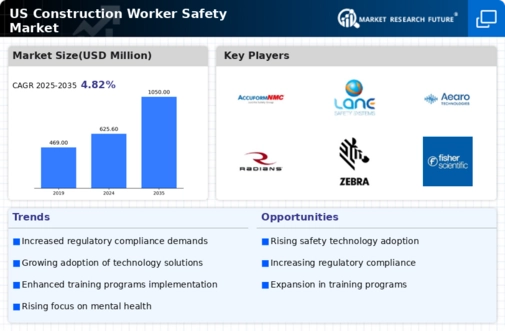Growing Awareness of Mental Health
The construction worker-safety market is increasingly influenced by the growing awareness of mental health issues among workers. Mental well-being is now recognized as a critical component of overall safety. Construction companies are beginning to implement programs that address mental health, providing resources and support for workers. Research indicates that mental health issues can lead to decreased productivity and increased accident rates. By fostering a supportive environment, companies can enhance worker morale and safety. This shift towards mental health awareness is likely to drive demand for related services and products within the construction worker-safety market.
Increased Focus on Training Programs
The construction worker-safety market experiences a notable driver in the form of enhanced training programs. As safety regulations become more stringent, construction companies are investing heavily in comprehensive training initiatives. These programs aim to educate workers on safety protocols, hazard recognition, and emergency response. According to the Occupational Safety and Health Administration (OSHA), effective training can reduce workplace injuries by up to 30%. This emphasis on training not only fosters a culture of safety but also aligns with the industry's commitment to compliance. Consequently, the demand for advanced training solutions is likely to grow, propelling the construction worker-safety market forward.
Adoption of Wearable Safety Technology
The integration of wearable safety technology serves as a significant driver in the construction worker-safety market. Devices such as smart helmets, vests with sensors, and health monitoring wearables are gaining traction. These technologies provide real-time data on worker health and environmental conditions, potentially reducing accidents. A report indicates that the wearable technology market in construction is projected to reach $2 billion by 2026, reflecting a compound annual growth rate (CAGR) of 25%. This trend suggests that as construction firms prioritize worker safety, the adoption of such technologies will likely expand, thereby enhancing overall safety standards.
Emergence of Safety-First Corporate Culture
The establishment of a safety-first corporate culture is emerging as a pivotal driver in the construction worker-safety market. Companies that prioritize safety are not only compliant with regulations but also experience lower insurance costs and higher employee retention rates. A safety-first approach fosters a proactive attitude towards risk management, encouraging workers to engage in safe practices. This cultural shift is supported by studies showing that organizations with strong safety cultures can reduce incident rates by up to 50%. As more companies recognize the benefits of such a culture, the construction worker-safety market is likely to see increased investment in safety initiatives.
Regulatory Compliance and Standards Enhancement
The construction worker-safety market is significantly impacted by the ongoing evolution of regulatory compliance and safety standards. Government agencies are continuously updating regulations to enhance worker safety, which compels construction firms to adapt their practices. Compliance with these regulations not only mitigates legal risks but also promotes a safer work environment. The financial implications of non-compliance can be severe, with penalties reaching thousands of dollars. As regulations become more stringent, the demand for compliance solutions and safety equipment is expected to rise, thereby driving growth in the construction worker-safety market.























Leave a Comment